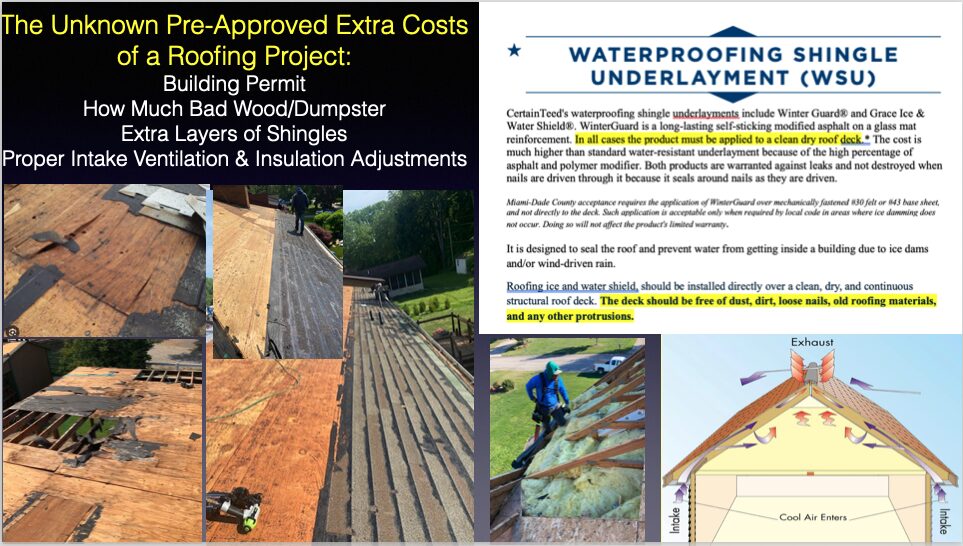
1.) In larger municipalities, the local Municipality Building Permit is determined by the total cost of the construction project. Conversely, in smaller rural areas, a flat fee is typically applied. As outlined in our agreement, instead of increasing the fee based on a markup, we simply charge an additional $40 for the time it takes to complete the application, submit it, pay for it, and receive it for the necessary work.
2.) How much defective wood is found that the manufacturer and local building codes mandate must be replaced, along with any additional dumpsters required for disposing of the wood? Regrettably, it is not possible to determine the situation until the old shingles are removed.
Shingle manufacturers and local building codes mandate that all damaged wood be replaced. Additionally, where new waterproof underlayment is required, the roof deck must “in all cases…be applied to a clean, dry roof deck.” The deck should be free of dust, dirt, loose nails, old roof materials, and any other protrusions.
Historically, homes reroofed prior to 2001 did not have any ice and water shield or proper ventilation installed. This caused roofs to deteriorate on average between 17 to 19 years even though their warranty was for 25/30 years. Severe granule loss, decking that is delaminated, buckled or areas where the roof leaked or were damaged by ice dams. These roofs typically had 4 to 10 sheets of 7/16th’s OSB that needed to be replaced. Roofs requiring replacement after 2001 may necessitate more extensive wood replacement due to the “clean” roof deck requirements. This requirement can necessitate 30 or more sheets of OSB to meet the standards and validate the new shingles warranty. In some instances, installing new 1/4-inch OSB decking over the entire roof deck may be more cost-effective.
When our crews encounter this situation, it becomes the most challenging aspect of any roofing project. They must halt and estimate the potential number of replacement sheets, even before removing most of the existing shingles. Subsequently, they must retrieve the OSB, nails, H-clips, and saw blades. Pry up, cut, and cut up the decking to fit into the dumpster, thereby minimizing additional space and preventing an additional charge for another dumpster. This is the reason we charge $90 per sheet, which is less than most companies. No other roofing work can be performed on the roof until the exposed wood areas have been replaced, and new waterproof and water-resistant underlayment has been installed before the end of the day.
Upon the identification of defective wood, our agreement outlines the necessary procedures. The foreman is mandated to inform our office and you, if available, of the situation. They are required to document the affected area by taking photographs before, during, and after the incident. These photographs will serve as evidence for the wood replacement required. Our office will then compile an invoice that includes the quantity of defective wood purchased from our supplier. The invoice serves as a formal document of the purchase but is not due until the project is completed. We will credit any unused wood and reflect this on the final statement.
3.) Additional Labor for Extra Layers of Shingles:
If extra layers of shingles are discovered, additional labor is necessary to remove, clean, and dispose of the debris in a dumpster, potentially requiring an additional dumpster (extra charge). Determining the number of layers of shingles on a home can be challenging. While most homes have only one layer, some may have two or three layers that were applied before building codes were revised to limit the number of layers to two.
4.) The Cost of Proper Intake Ventilation
Proper intake ventilation is closely intertwined with exhaust ventilation, as one cannot function effectively without the other. While most homes have some form of ventilation, it is often challenging to determine the adequacy of intake ventilation before a roof project commences. Framing and insulation in the attic may obstruct vents, preventing cooler dryer air from entering and circulating throughout the attic, while simultaneously allowing humid hot air to escape through the exhaust vents.
Many newer homes have multiple attics, some even several, that remain inaccessible until the roofing process begins. Once the shingle removal process commences, our crews gain access to all the attics. During this phase, they can assess whether insulation adjustments are necessary (incurring additional costs) and determine if any additional intake venting is required (extra cost).